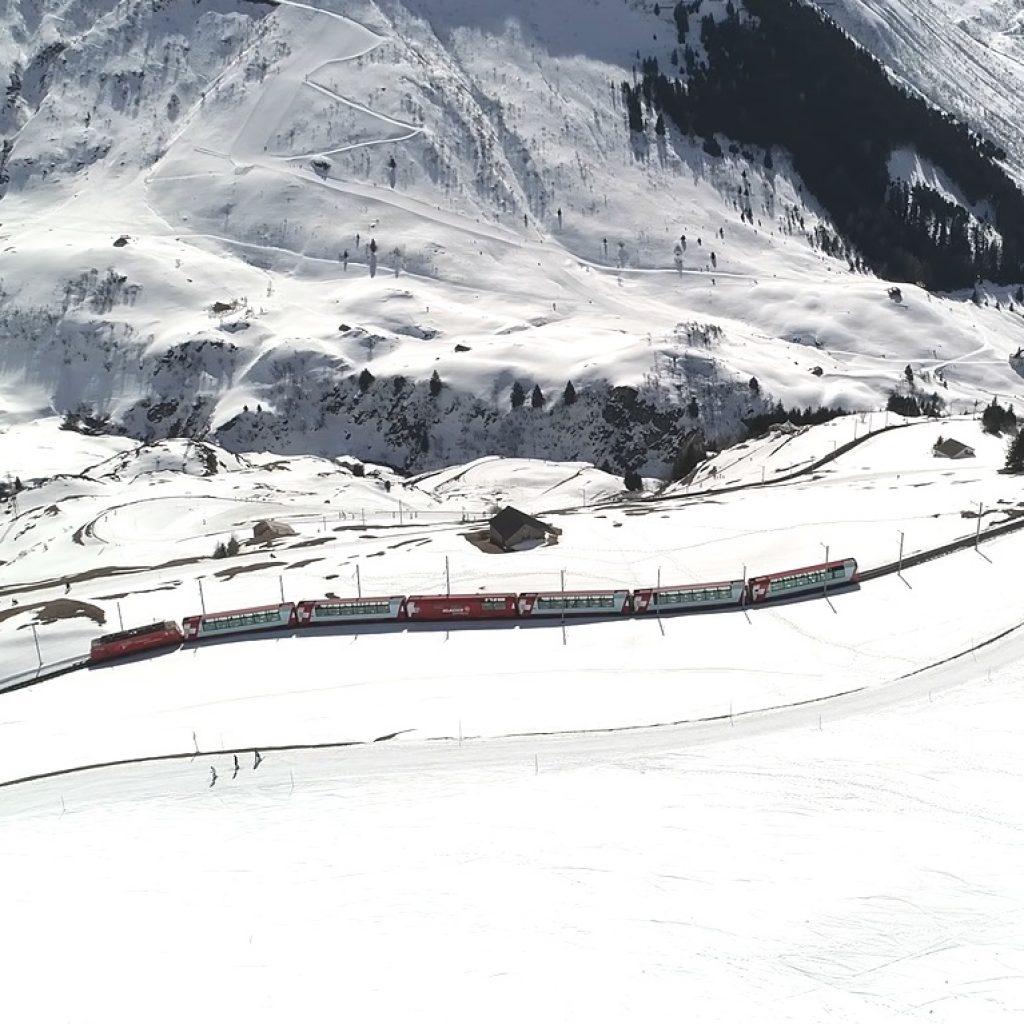
A Journey Like No Other
The Glacier Express is more than just a train ride; it’s an unparalleled journey through the heart of the Swiss Alps. Known as the “world’s slowest express train,” this iconic route spans 291 kilometers (180 miles) from Zermatt to St. Moritz, covering some of Switzerland’s most breathtaking landscapes. Over the course of approximately 8 hours, passengers are treated to panoramic views of pristine valleys, snow-capped peaks, charming alpine villages, and majestic bridges. The Glacier Express isn’t just a mode of transportation—it’s an immersive experience that combines luxury, comfort, and natural beauty.
But what makes the Glacier Express truly special? It’s the seamless blend of world-class service, gourmet dining, and the feeling of being enveloped by nature’s grandeur. Whether you’re a seasoned traveler or a first-time visitor to Switzerland, the Glacier Express offers a unique perspective on the country’s iconic landscapes. This guide will take you through every aspect of the Glacier Express journey, from its historical roots to the best tips for planning your trip. By the end, you’ll understand why this journey is a must-experience for anyone visiting Switzerland.
History and Legacy of the Glacier Express
The Inception of the Glacier Express
The Glacier Express made its inaugural journey on June 25, 1930, establishing a direct link between Zermatt, home of the iconic Matterhorn, and the luxury resort town of St. Moritz. The idea was to create a scenic train route that would showcase the best of Switzerland’s natural beauty while providing a comfortable and efficient mode of transportation across the Alps. The train was a collaboration between three railway companies: the Brig-Visp-Zermatt-Bahn (BVZ), the Furka Oberalp Bahn (FOB), and the Rhätische Bahn (RhB).
At the time, the Glacier Express was considered a marvel of engineering, especially given the challenging alpine terrain it traversed. The route required the construction of numerous tunnels, viaducts, and bridges, including the famous Landwasser Viaduct, which remains a highlight of the journey today. Despite these challenges, the Glacier Express quickly became popular among tourists, offering a unique way to experience the Swiss Alps.
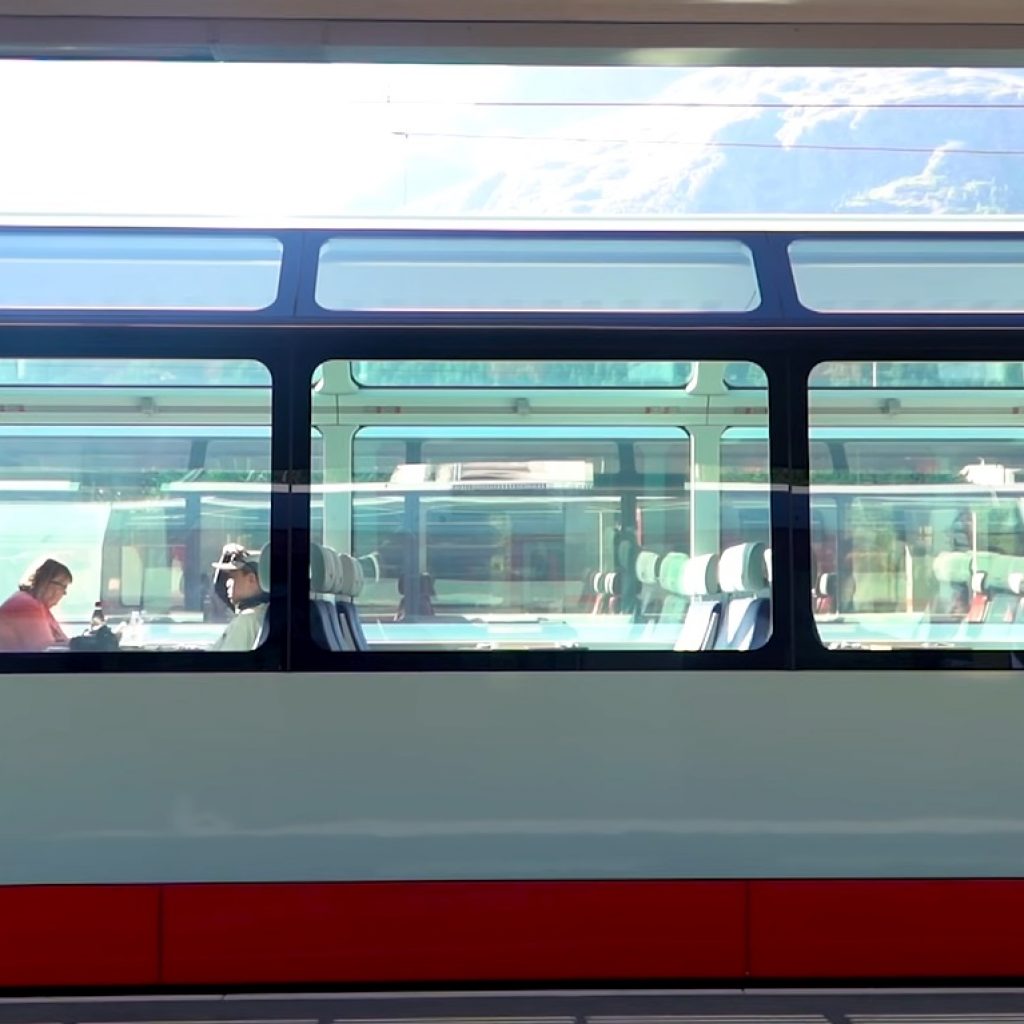
Evolution Over the Decades
Over the years, the Glacier Express has undergone significant changes and upgrades, evolving from a basic means of transportation into a luxury travel experience. In the early years, the train ran only during the summer months, as the high alpine passes were impassable in winter. However, by 1982, with the completion of the Furka Base Tunnel, the Glacier Express became a year-round service, allowing passengers to experience the stunning winter landscapes of the Swiss Alps.
One of the most significant upgrades came in the 1980s with the introduction of panoramic windows, offering passengers unobstructed views of the surrounding landscapes. This innovation transformed the Glacier Express into the scenic marvel it is today, allowing travelers to fully immerse themselves in the beauty of the journey.
The train itself has also seen improvements in terms of comfort and luxury. Modern Glacier Express trains feature air-conditioned carriages, comfortable seating, and state-of-the-art amenities. The introduction of the Excellence Class in 2019 took luxury to new heights, offering an exclusive experience with gourmet dining, dedicated concierge service, and extra-spacious seating.
The Glacier Express in Popular Culture
The Glacier Express has not only captivated the hearts of travelers but has also made its mark in popular culture. Over the years, it has been featured in numerous travel documentaries, films, and books, further cementing its status as a must-do experience for visitors to Switzerland. The train’s iconic route, with its stunning landscapes and engineering marvels, has made it a symbol of Swiss tourism.
The Glacier Express has been the subject of various travel shows and documentaries, showcasing its scenic route and luxurious offerings. It’s often highlighted as one of the world’s most beautiful train journeys, drawing the attention of travel enthusiasts and adventurers alike.
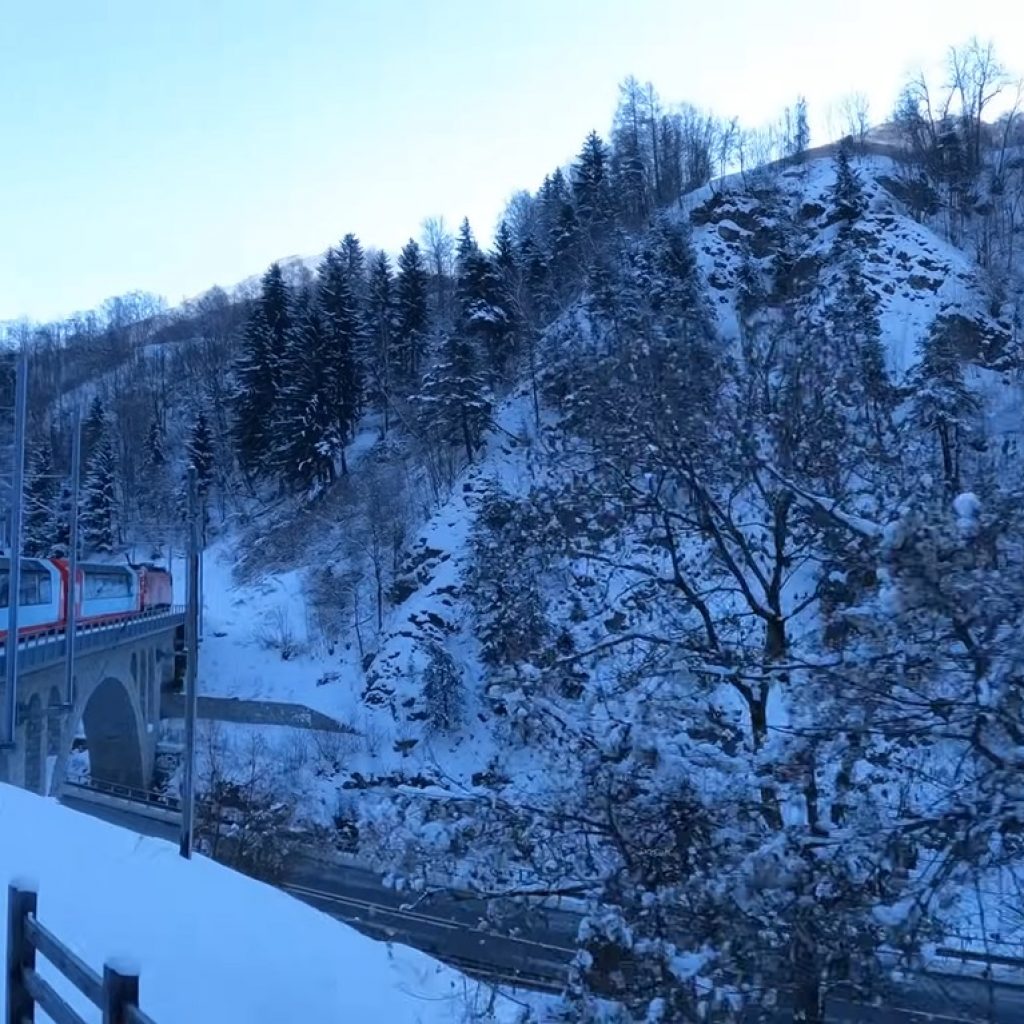
Route Overview and Major Stops
Starting Point: Zermatt
Nestled at the foot of the Matterhorn, Zermatt is a picturesque alpine village that serves as the starting point for the Glacier Express journey. Known for its car-free streets, charming chalets, and world-class ski resorts, Zermatt is a destination in its own right. Before boarding the Glacier Express, travelers can explore Zermatt’s numerous attractions, including the Gornergrat Railway, which offers panoramic views of the Matterhorn and surrounding peaks.
Zermatt is also a haven for outdoor enthusiasts, with endless opportunities for hiking, skiing, and mountaineering. The Matterhorn Museum provides insights into the history of the region and the daring ascents of the Matterhorn. For a touch of luxury, visitors can indulge in fine dining at one of Zermatt’s gourmet restaurants or relax in a spa with views of the majestic Alps.
Brig: Gateway to the Simplon Pass
Brig is the first major stop on the Glacier Express route, located in the upper Rhone Valley. This charming town is known for its historic old town, the Stockalper Palace, and its proximity to the Simplon Pass. The Simplon Pass has historically been an important trade route, connecting Switzerland to Italy.
Travelers stopping in Brig can explore the town’s cobblestone streets, visit the baroque Stockalper Palace, or take a scenic hike in the surrounding mountains. Brig is also a gateway to the Aletsch Glacier, the largest glacier in the Alps, offering stunning views and excellent opportunities for outdoor activities.
Andermatt: The Heart of the Alps
Situated in the heart of the Swiss Alps, Andermatt is a key stop along the Glacier Express route. This small alpine village has a rich history and is surrounded by some of the most dramatic landscapes in Switzerland. Andermatt has become increasingly popular as a year-round destination, offering skiing in winter and hiking, biking, and golfing in summer.
One of the highlights of Andermatt is the Oberalp Pass, the highest point on the Glacier Express route. The pass offers breathtaking views of the surrounding mountains and valleys, making it a favorite spot for photographers. Andermatt is also home to the historic Gemsstock mountain, a popular destination for advanced skiers.
Chur: Switzerland’s Oldest City
As the oldest city in Switzerland, Chur offers a fascinating blend of history, culture, and modern amenities. The Glacier Express passes through Chur, providing passengers with a glimpse of this ancient city’s charming old town, with its narrow streets, medieval buildings, and vibrant atmosphere.
Chur is a cultural hub with several museums, galleries, and theaters. The city is also a gateway to the Graubünden region, known for its beautiful landscapes, including the Rhine Gorge, often referred to as the “Swiss Grand Canyon.” Visitors can explore Chur’s history at the Rätisches Museum or take a leisurely stroll through the old town, soaking in the city’s rich heritage.
Final Destination: St. Moritz
The Glacier Express journey culminates in the world-renowned resort town of St. Moritz. Known for its luxury hotels, gourmet dining, and elite clientele, St. Moritz is synonymous with glamour and sophistication. The town has hosted the Winter Olympics twice and is a top destination for skiing, snowboarding, and winter sports.
St. Moritz is not only a winter paradise but also offers a wealth of activities in the summer. Visitors can enjoy hiking, mountain biking, and sailing on the pristine lakes. The town is also famous for its cultural events, including the annual St. Moritz Art Masters and the White Turf horse races on the frozen lake.
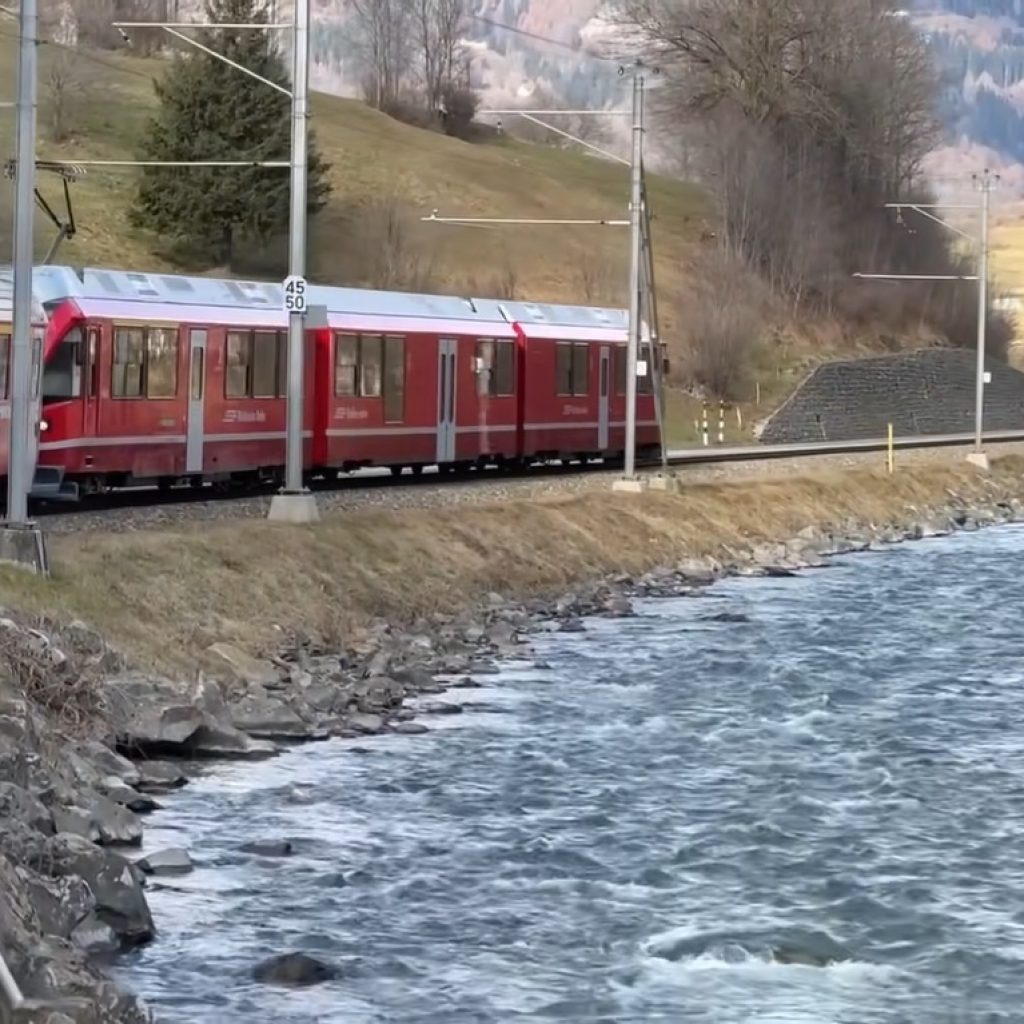
Scenic Highlights Along the Glacier Express Route
The Rhone Valley
As the Glacier Express leaves Zermatt, it enters the picturesque Rhone Valley, where lush vineyards, charming villages, and alpine meadows create a serene and idyllic landscape. The Rhone Valley is known for its terraced vineyards that produce some of Switzerland’s finest wines, particularly the white wine made from the Chasselas grape.
The scenery in the Rhone Valley changes with the seasons, offering a unique experience year-round. In spring and summer, the valley is vibrant with blooming flowers and lush greenery, while in autumn, the vineyards turn a golden hue. Winter transforms the landscape into a snowy wonderland, with the white-capped peaks contrasting against the deep blue sky.
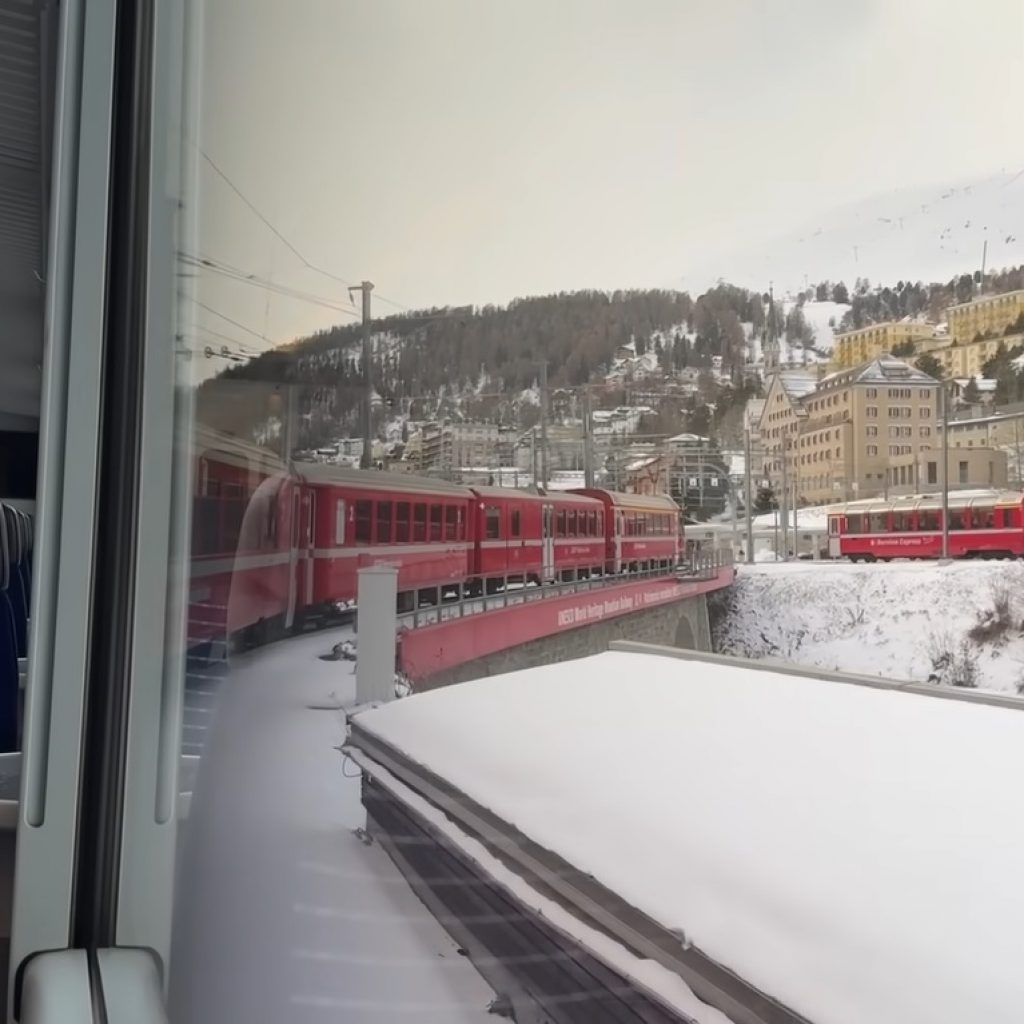
Oberalp Pass: The Highest Point
The Glacier Express reaches its highest point at the Oberalp Pass, which sits at an elevation of 2,033 meters (6,670 feet) above sea level. This section of the journey is one of the most dramatic, offering passengers panoramic views of the snow-covered mountains, alpine lakes, and winding valleys.
The Oberalp Pass is a highlight for photographers and nature lovers, with its breathtaking vistas and ever-changing landscapes. In winter, the pass is blanketed in snow, creating a magical winter wonderland, while in summer, the alpine meadows are dotted with wildflowers, and the lakes reflect the surrounding peaks.
The Landwasser Viaduct
One of the most iconic landmarks along the Glacier Express route is the Landwasser Viaduct, an engineering marvel and a UNESCO World Heritage site. The viaduct spans the Landwasser River, with six limestone arches towering 65 meters (213 feet) above the gorge below. The train crosses this stunning structure as it curves into a tunnel carved into the mountainside.
The Landwasser Viaduct is a testament to the ingenuity and skill of the engineers who designed it. The viaduct has become a symbol of the Glacier Express, with its graceful arches and dramatic setting making it one of the most photographed spots along the route.
The Rhine Gorge: Switzerland’s Grand Canyon
As the Glacier Express approaches Chur, it passes through the Rhine Gorge, often referred to as the “Swiss Grand Canyon.” This dramatic landscape was formed over millions of years by the Rhine River carving its way through the limestone cliffs, creating deep gorges and towering rock formations.
The Rhine Gorge offers some of the most spectacular scenery along the Glacier Express route, with its steep cliffs, emerald green waters, and lush forests. Passengers can marvel at the raw beauty of this natural wonder as the train winds its way through the gorge, offering ever-changing views of this unique landscape.
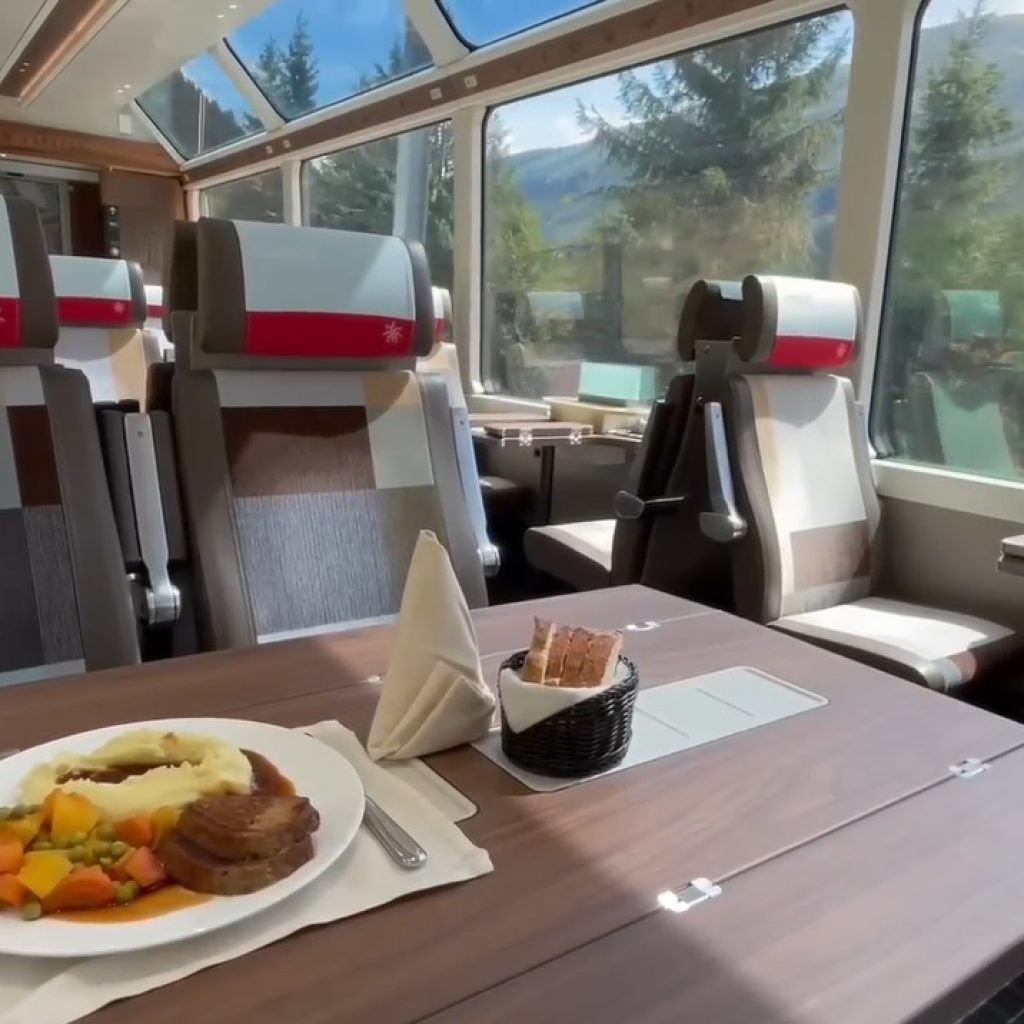
Onboard Experience
Panoramic Views from Every Seat
One of the defining features of the Glacier Express is its panoramic windows, designed to provide uninterrupted views of the stunning landscapes outside. These large windows extend up to the ceiling, allowing passengers to fully appreciate the towering mountains, deep valleys, and picturesque villages that the train passes through.
Whether you’re sitting on the left or right side of the train, you’re guaranteed a front-row seat to some of the most beautiful scenery in the world. The panoramic windows also make it easy to take photos without having to leave your seat, capturing the breathtaking moments that define the Glacier Express journey.
Gourmet Dining at 2,000 Meters
Dining on the Glacier Express is a highlight of the journey, with gourmet meals served directly to your seat. The onboard menu features a range of Swiss specialties, from traditional dishes like Zürcher Geschnetzeltes (sliced veal in a creamy mushroom sauce) to modern culinary creations using local ingredients.
Each meal is paired with a selection of fine wines from Switzerland’s best vineyards, offering a true taste of the region. The dining experience is enhanced by the stunning views outside, making it a feast for both the eyes and the palate. Whether you choose a three-course meal or a light snack, the culinary experience on the Glacier Express is designed to delight.
Excellence Class: The Pinnacle of Luxury
For those seeking the ultimate in luxury, the Glacier Express offers Excellence Class, an exclusive carriage that redefines first-class travel. Excellence Class passengers enjoy spacious, reclining seats with ample legroom, large panoramic windows, and a dedicated concierge service.
The Excellence Class experience includes a five-course gourmet meal with wine pairings, served on fine china with silver cutlery. Passengers also have access to a private bar, where they can enjoy a selection of premium beverages, including champagne and Swiss liqueurs. With only 20 seats available, Excellence Class offers an intimate and personalized experience, making it the most luxurious way to travel on the Glacier Express.
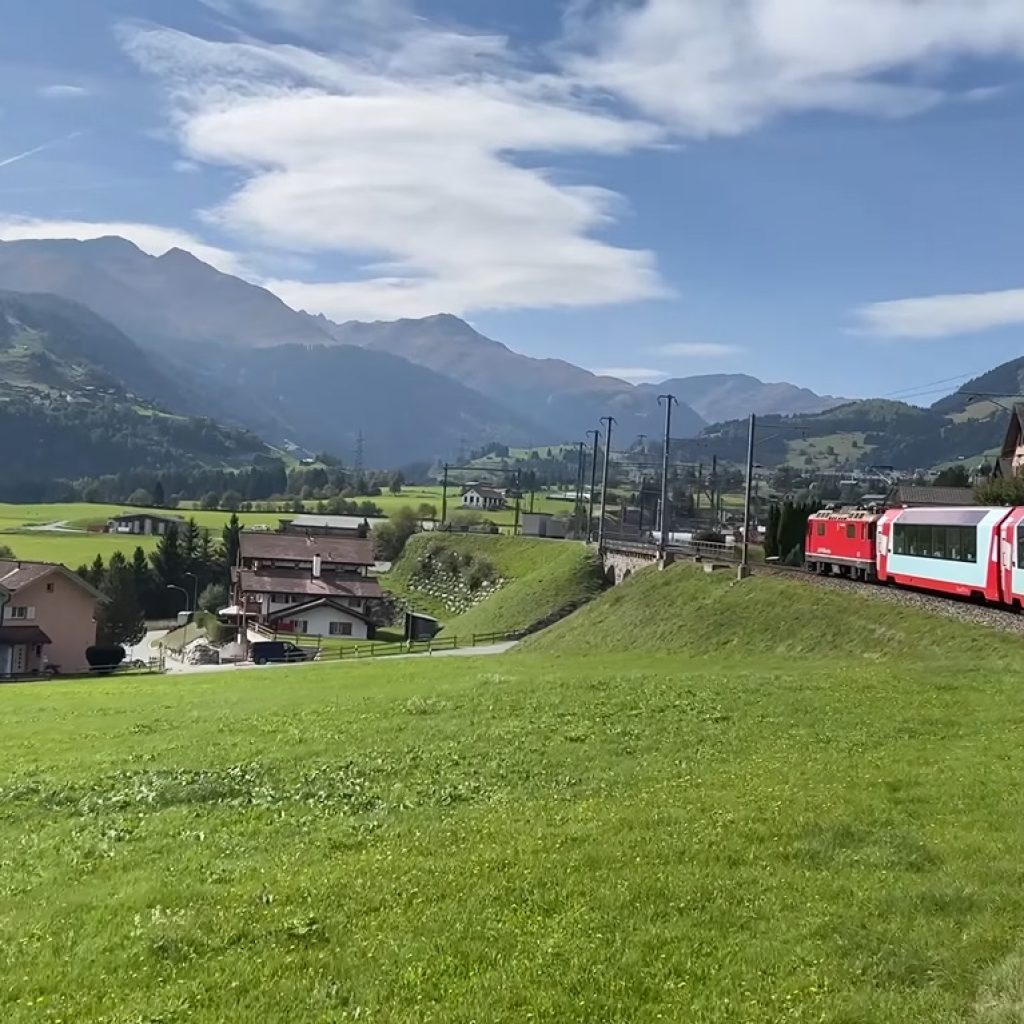
Planning Your Glacier Express Journey
Best Time to Travel
The Glacier Express operates year-round, and each season offers a unique experience. In winter, the snow-covered landscapes create a magical atmosphere, with frozen lakes, frosted trees, and sparkling white peaks. This is the perfect time for those who want to experience a true winter wonderland.
Spring and summer bring a burst of color to the Alps, with wildflowers in full bloom, green valleys, and clear blue skies. The warmer weather makes it ideal for outdoor activities before or after your train journey, such as hiking, biking, or exploring the charming villages along the route.
Autumn is another beautiful time to travel on the Glacier Express, as the forests turn golden and the vineyards are harvested. The changing colors of the leaves create a stunning contrast against the deep blue sky and the white peaks of the mountains.
Booking Tickets and Classes
Booking tickets for the Glacier Express is easy and can be done online through the official website or at major train stations in Switzerland. There are three classes to choose from: second class, first class, and Excellence Class.
- Second Class: Offers comfortable seating with access to panoramic windows. It’s a great option for budget-conscious travelers who still want to enjoy the scenic views.
- First Class: Provides more spacious seating and larger windows, making it a popular choice for those seeking extra comfort.
- Excellence Class: The pinnacle of luxury, with only 20 seats available, offering a personalized experience with gourmet dining, dedicated service, and exclusive amenities.
It’s advisable to book your tickets well in advance, especially if you’re traveling during peak seasons or wish to travel in Excellence Class, as availability can be limited.
Choosing the Best Seats
When booking your Glacier Express tickets, you can select your preferred seats. While every seat offers excellent views, there are a few tips to consider for the best experience:
- Direction of Travel: If you prefer to face forward, make sure to select a seat that corresponds with the direction of travel. This can enhance your viewing experience, especially when approaching scenic highlights.
- Window Seats: Window seats are ideal for photography and uninterrupted views. In Excellence Class, all seats are by the window.
- Scenic Side: Both sides of the train offer spectacular views, but some travelers prefer the right side when traveling from Zermatt to St. Moritz for better views of the Matterhorn and other landmarks. However, the left side provides better views of the Rhine Gorge. Ultimately, there’s no wrong choice, as the train’s panoramic windows ensure you’ll have an incredible experience from any seat.
Luggage and Accessibility
The Glacier Express is well-equipped to handle luggage, with designated storage areas in each carriage. Passengers are allowed to bring standard-sized luggage and hand luggage on board. If you’re traveling with large or heavy luggage, it’s recommended to use the luggage forwarding service offered by Swiss Railways, which allows you to travel hands-free.
The train is also accessible for passengers with limited mobility. Ramps and lifts are available for boarding and disembarking, and accessible toilets are provided in certain carriages. It’s advisable to inform the train staff in advance if you require any special assistance to ensure a smooth and comfortable journey.
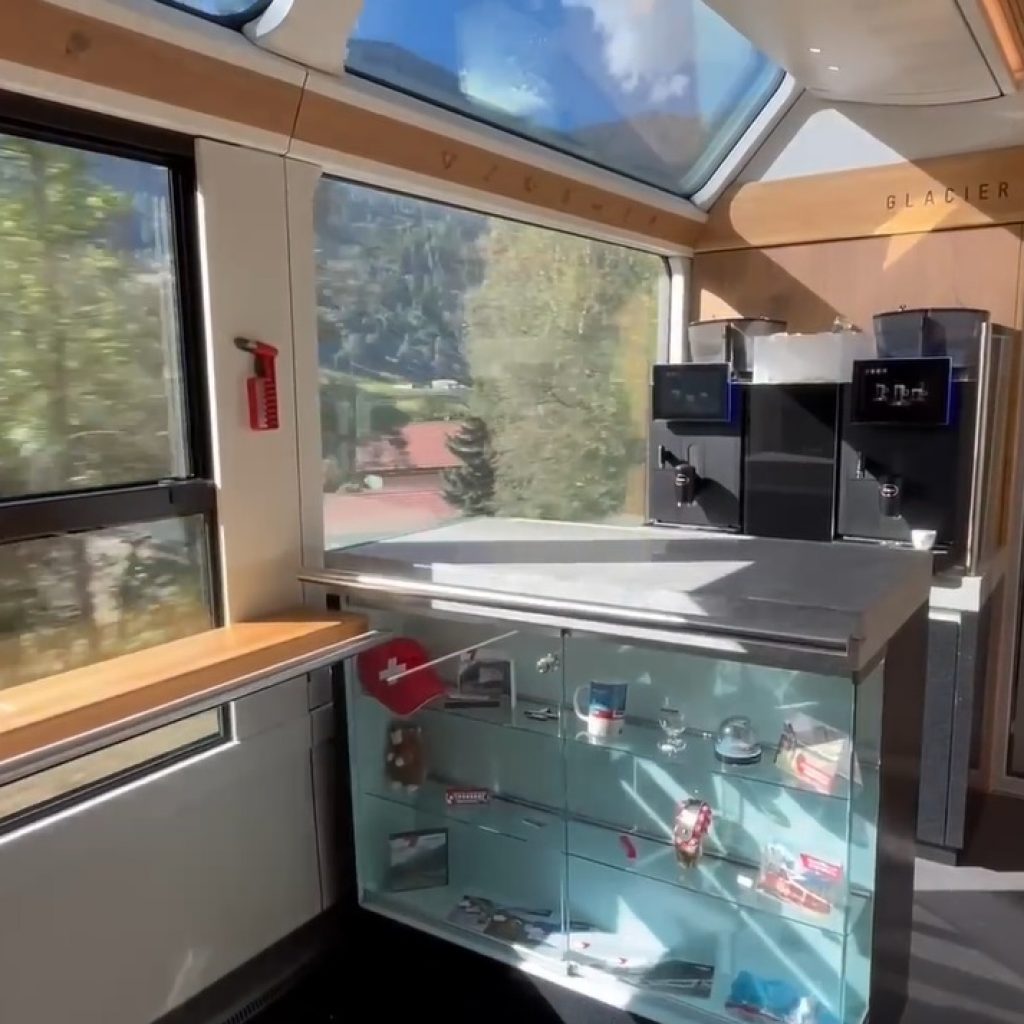
Excursions and Activities Along the Route
Zermatt: Gateway to the Matterhorn
Before embarking on the Glacier Express, consider spending a few days in Zermatt, one of Switzerland’s most iconic destinations. Zermatt offers a range of activities, from hiking and skiing to exploring the village’s charming streets lined with boutique shops, cozy cafes, and gourmet restaurants.
A must-do in Zermatt is taking the Gornergrat Railway, a cogwheel train that ascends to 3,089 meters (10,135 feet) above sea level, offering panoramic views of the Matterhorn and the surrounding peaks. For those seeking adventure, Zermatt offers a range of outdoor activities, including mountaineering, paragliding, and helicopter tours.
Andermatt: Outdoor Adventures in the Alps
Andermatt is a paradise for outdoor enthusiasts, offering year-round activities in the heart of the Swiss Alps. In winter, the region is a top destination for skiing, with access to over 120 kilometers (75 miles) of slopes. The Gemsstock mountain is particularly popular among advanced skiers, offering challenging runs and off-piste opportunities.
In summer, Andermatt transforms into a haven for hikers, bikers, and golfers. The region offers a network of well-marked hiking trails, ranging from leisurely walks to challenging alpine hikes. The Andermatt Swiss Alps Golf Course is one of the most scenic courses in Europe, offering 18 holes surrounded by breathtaking mountain views.
Chur: A Stroll Through History
Chur, Switzerland’s oldest city, is a treasure trove of history and culture. Spend a day exploring the city’s well-preserved old town, with its narrow streets, medieval buildings, and charming squares. The Rätisches Museum offers insights into the region’s history, while the Art Museum Chur showcases works by Swiss artists.
Chur is also a gateway to the Graubünden region, known for its stunning landscapes and outdoor activities. Take a day trip to the nearby Rhine Gorge or explore the hiking and biking trails that wind through the surrounding mountains.
St. Moritz: Luxury and Leisure
St. Moritz is the epitome of alpine luxury, offering a range of activities and attractions for discerning travelers. In winter, the town is a hub for skiing, snowboarding, and other winter sports, with access to over 350 kilometers (217 miles) of slopes. The frozen Lake St. Moritz is the site of the famous White Turf horse races and the Snow Polo World Cup.
In summer, St. Moritz offers a wealth of activities, including hiking, mountain biking, and sailing on the pristine lakes. The town is also known for its cultural events, including the St. Moritz Art Masters and the Festival da Jazz. For those seeking relaxation, St. Moritz offers world-class spas, gourmet dining, and luxury shopping.
Glacier Express Tips and Tricks
Photography Tips
Capturing the beauty of the Glacier Express journey requires some planning and the right equipment. Here are a few tips to help you get the best shots:
- Panoramic Windows: Take advantage of the train’s large panoramic windows to capture wide-angle shots of the landscape. A lens with a focal length of 24-70mm is ideal for capturing both the vast landscapes and the details of the scenery.
- Timing: The best light for photography is during the early morning or late afternoon, when the sun is lower in the sky. This creates softer, more dramatic lighting, perfect for capturing the mountains and valleys.
- Reflection Reduction: To avoid reflections from the train windows, use a polarizing filter on your camera lens. Alternatively, press your camera lens against the window to minimize reflections.
- Quick Access: Keep your camera ready at all times, as the scenery changes rapidly, and you don’t want to miss any photo opportunities. Consider using a camera strap or wrist strap for easy access.
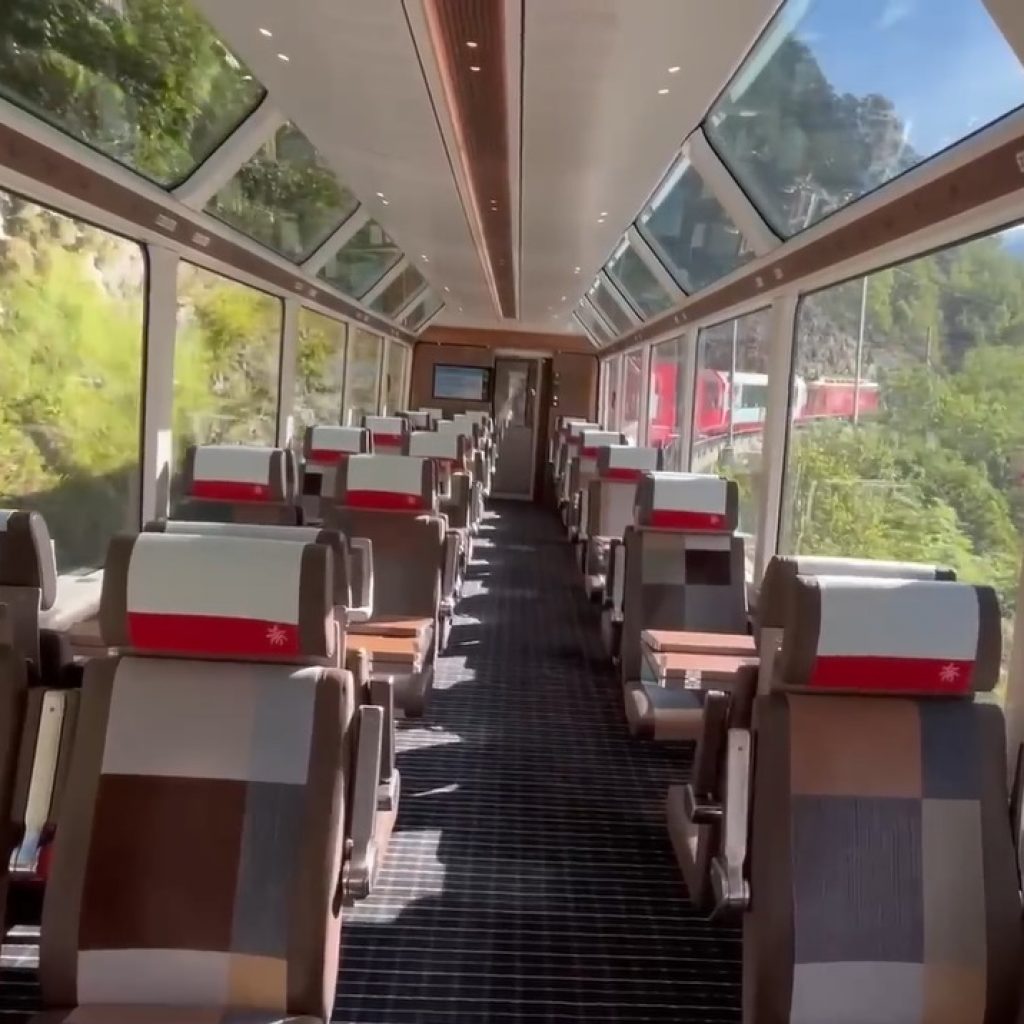
Maximizing Comfort on Board
To ensure a comfortable and enjoyable journey on the Glacier Express, consider the following tips:
- Layered Clothing: The weather can vary along the route, especially when traveling through different altitudes. Wear layered clothing that can be easily adjusted to stay comfortable throughout the journey.
- Hydration: The dry air at high altitudes can lead to dehydration, so it’s important to drink plenty of water during the trip. Bottled water is provided on board, but it’s also a good idea to bring your own.
- Entertainment: While the stunning scenery is the main attraction, consider bringing a book, magazine, or tablet for entertainment during the quieter stretches of the journey. The Glacier Express also offers an audio guide with information about the landmarks and regions along the route.
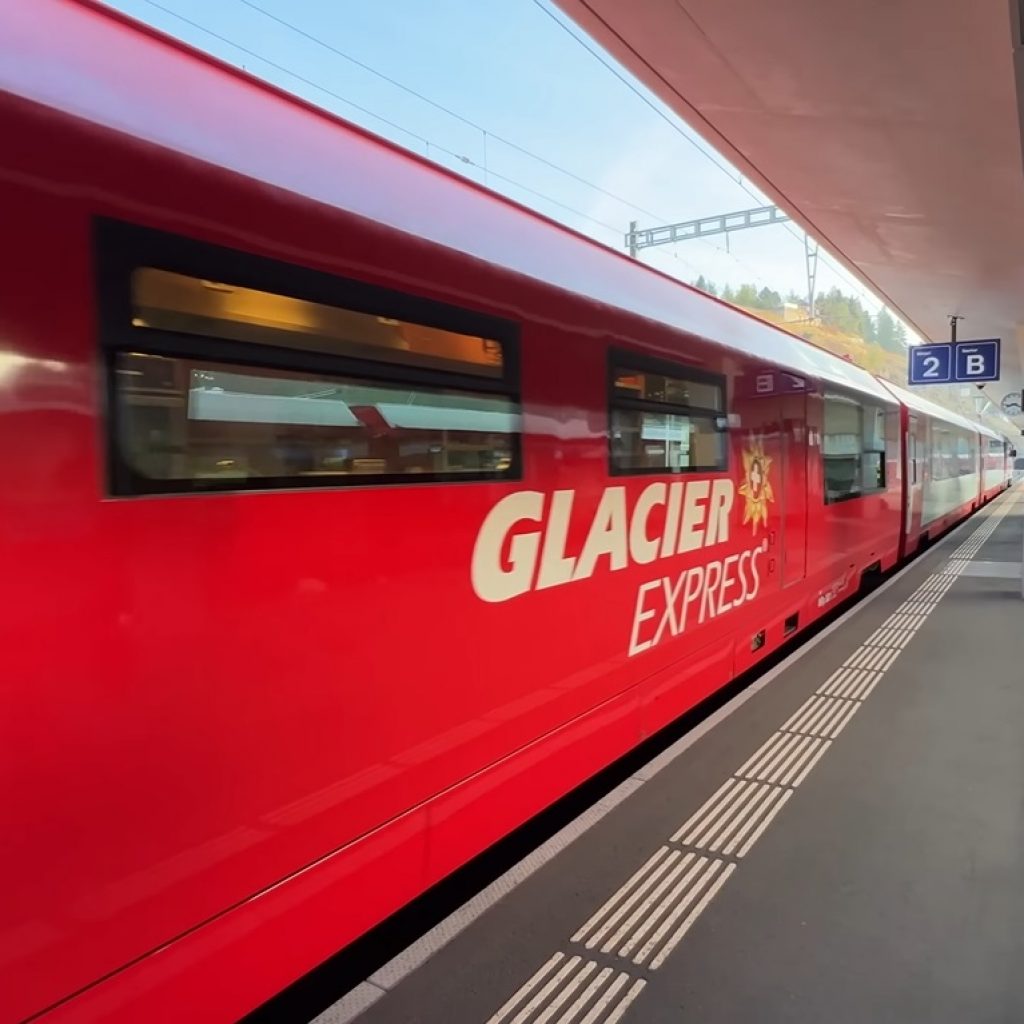
Making the Most of Stopovers
If your Glacier Express journey includes stopovers, make the most of your time by exploring the towns and attractions along the route. Here are a few ideas:
- Zermatt: Take a cable car to the Matterhorn Glacier Paradise, the highest cable car station in Europe, offering 360-degree views of the Alps.
- Andermatt: Visit the Devil’s Bridge, a historic stone bridge spanning the Schöllenen Gorge, steeped in Swiss folklore.
- Chur: Take a scenic walk along the Rhine River or visit the nearby vineyards for a wine-tasting experience.
- St. Moritz: Explore the Engadine Valley on foot or by bike, or take a relaxing boat ride on Lake St. Moritz.
By planning your stopovers and excursions in advance, you can add even more unforgettable experiences to your Glacier Express adventure.
Glacier Express FAQs
What is the best time of year to travel on the Glacier Express?
The Glacier Express offers a unique experience in every season. Winter is ideal for those who want to see snow-covered landscapes and experience the magic of a Swiss winter. Spring and summer are perfect for enjoying the vibrant colors of the Alps and taking advantage of outdoor activities. Autumn offers stunning fall foliage and a quieter, more peaceful journey.
How long is the Glacier Express journey?
The Glacier Express journey covers approximately 291 kilometers (181 miles) and takes around 7 to 8 hours, depending on the direction of travel and any stopovers along the route.
What should I wear on the Glacier Express?
Comfortable, layered clothing is recommended, as temperatures can vary throughout the journey. In winter, bring a warm coat, hat, and gloves. In summer, lighter clothing is appropriate, but a jacket is still advisable for cooler temperatures in the mountains.
Can I bring luggage on the Glacier Express?
Yes, you can bring luggage on the Glacier Express. There are designated storage areas in each carriage for standard-sized luggage. If you have large or heavy luggage, consider using the luggage forwarding service offered by Swiss Railways.
Is the Glacier Express wheelchair accessible?
Yes, the Glacier Express is wheelchair accessible, with ramps and lifts available for boarding and disembarking. Accessible toilets are also provided in certain carriages. It’s recommended to inform the train staff in advance if you require any special assistance.
Do I need to book Glacier Express tickets in advance?
Yes, it’s advisable to book your Glacier Express tickets in advance, especially during peak travel seasons or if you wish to travel in Excellence Class. Tickets can be booked online or at major train stations in Switzerland.
Are meals included on the Glacier Express?
Meals are not included in the standard ticket price, but you can purchase a range of dining options on board, from snacks to gourmet meals. If you’re traveling in Excellence Class, a five-course meal with wine pairings is included.
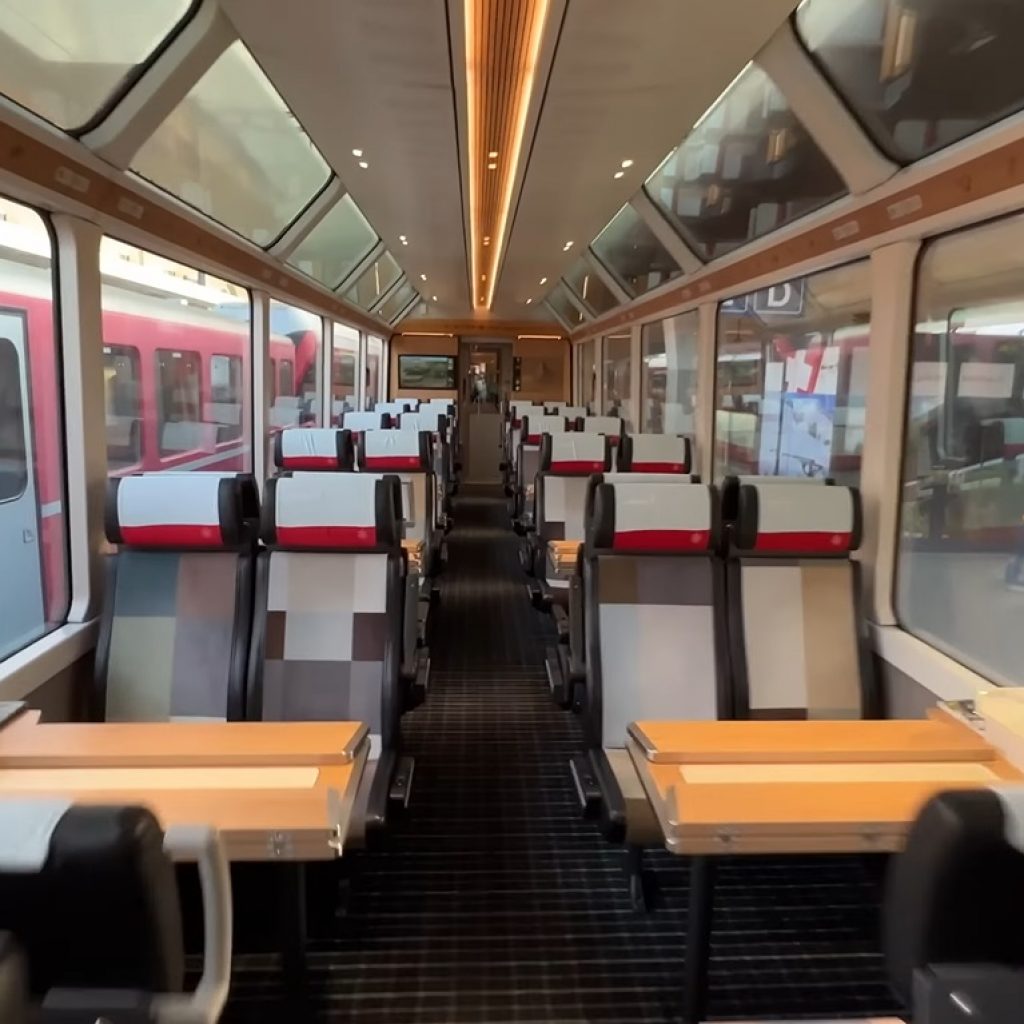
The Glacier Express is more than just a train journey; it’s an unforgettable experience that takes you through some of the most breathtaking landscapes in the world. Whether you’re traveling in winter, spring, summer, or autumn, the Glacier Express offers a unique perspective on the beauty of the Swiss Alps.
From the panoramic views and gourmet dining to the luxury of Excellence Class, every aspect of the Glacier Express is designed to provide a memorable and luxurious travel experience. Whether you’re a first-time visitor to Switzerland or a seasoned traveler, the Glacier Express is a must-do experience that will leave you with lasting memories of the Swiss Alps’ stunning beauty.




Comment (0)